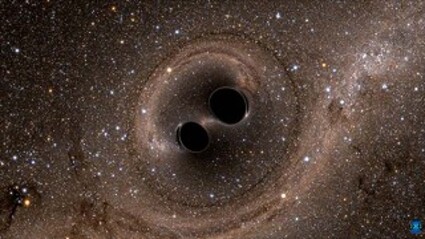Exploring gravitational waves
Last updated 3/20/2018 at Noon

courtesy Simulating eXtreme Spacetimes project - www.black-holes.org
The collision of two black holes is illustrated in this computer simulation. The two merging black holes are roughly 30 times the mass of the sun.
The Laser Interferometer Gravitational wave Observatory (LIGO) collaboration made two historic announcements in February 2016.
The first was that gravitational waves, predicted by Albert Einstein 100 years earlier, had been definitively observed for the first time. The second was that those waves constituted the first observation of the merger of two distant black holes, not detectable by any other means and indicating the power for discovery of this brand-new way of observing the universe.
Gravitational waves, it turns out, are literally disruptions in spacetime itself.
On Tuesday, March 27, Dr. Larry Price will highlight in accessible language the significance of gravitational waves to scientific understanding of the natural world and the immense technological achievement that resulted in their detection.
Dr. Price will speak at The Belfry as part of the Frontiers in Science lecture series sponsored by the Sisters Science Club. The lecture begins at 7 p.m.
Almost all past astronomy and cosmology has involved observations based on detecting electromagnetic radiation from the cosmos, whether by light, radio waves, or X-rays.
Such observations have led to better understanding of gravity and verification of Einstein's theories by finding anomalies in the motion of planets or the deviation of starlight during a solar eclipse.
But 2016's announcement of the first detection of gravitational waves - waves produced 1.3 billion years ago in the collision of two monstrous black holes - has shown how scientists can detect gravitational events directly.
The signal was extremely weak when it reached Earth, but the discovery promises an entirely new way of observing the farthest reaches of space and time.
Now scientists will be able not only to observe previously undetectable processes in the universe, Dr. Price explains, but also to correlate the observations we can already make with new information coming from gravitational waves.
Using a lively multimedia presentation, Dr. Price will help us understand the enormity of this scientific advance, which garnered the 2017 Nobel Prize in physics for LIGO's lead researchers.
Dr. Price, a physicist specializing in elementary particles, holds degrees in physics from Pomona College (BA) and Harvard University (MA and PhD). He is retired from a career at Argonne National Laboratory, where he held the rank of senior physicist and was director of the High Energy Physics Division. Although he did not participate in the LIGO experiment, he has maintained a keen interest in it from its inception. He has served on multiple national and international committees for particle physics and related fields, including the High Energy Physics Advisory Panel, the U.S. Federal Advisory Committee for elementary particle physics.
Social hour begins at 6 p.m. with light fare, beer, and wine available. The lecture begins at 7 p.m. Admission is $5; Science Club annual donors, teachers and students are admitted free. The Belfry is located at 302 E. Main Ave. in Sisters.















Reader Comments(0)